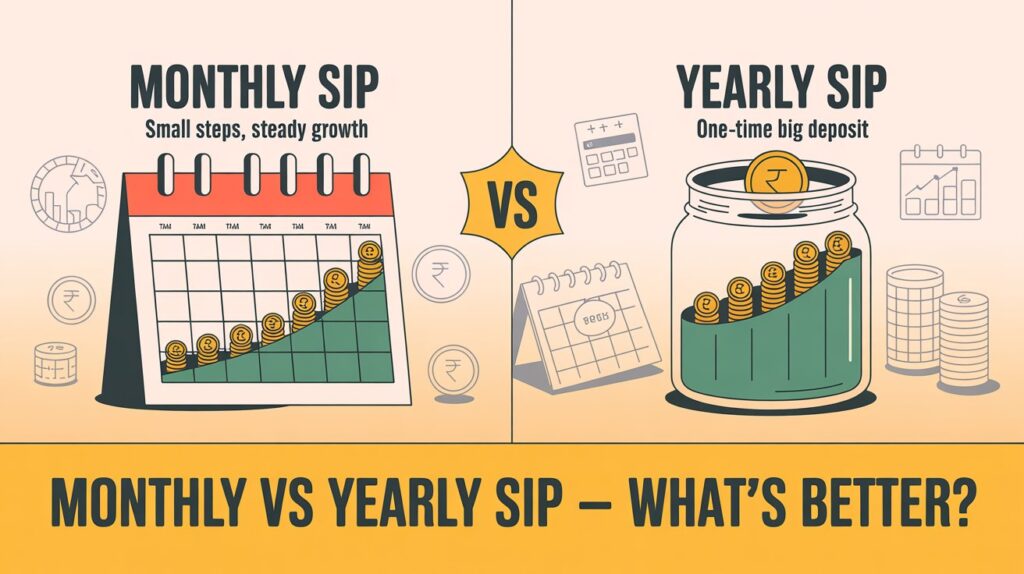In recent decades, SIPs have emerged as one of the most trusted ways to build long-term wealth. This approach involves breaking down large investments into smaller and more regular contributions. SIPs in mutual funds make participation in the market better and disciplined.
But you may have a common question – should you invest monthly or yearly? Most investors prefer monthly SIPs as it’s more convenient to deposit small, manageable amounts. However, others find yearly contributions more feasible.
Which type of SIP helps you grow your wealth faster? That’s what we have evaluated using SIP calculators in this blog for your convenience.
The Steady Approach with Monthly SIP
For many investors, monthly SIPs are more effective. They find it convenient to make a small contribution every month. In the process, they can easily handle volatility in the market instead of fearing it.
Monthly SIP has several advantages, like:
- When you invest regularly, you benefit from rupee cost averaging
- Monthly SIPs are ideal for salaried professionals with having predictable monthly income
- Since the returns are reinvested each month, compounding starts early
- As SIP contributions are automated, you can keep your emotions in check
Suppose you invest INR 5,000 each month. So, your money gets 12 opportunities to compound a year, which creates its own pattern. A monthly SIP return calculator can help you visualise this growth.
The Lump-Sum Style Commitment with yearly SIP
When you invest in your SIPs yearly, you need to put in a larger amount once a year. Instead of contributing INR 5,000 a month, you invest INR 60,000 per year. Those with irregular income, like business owners and individual contractors, often find this approach more convenient. People receiving annual bonuses also prefer investing in yearly SIPs.
Yearly SIP contributions also have certain advantages.
- Fewer transactions mean they are simpler to manage
- Those who prefer making one-time yearly commitments find this approach ideal
However, one of the drawbacks of yearly SIPs is that you miss out on the advantage of monthly compounding. Also, these investments fail to capture rupee cost averaging effectively.
Things You Must Consider Before Choosing the Frequency of Your SIP
When you choose between monthly and yearly SIPs, make sure to check out the following aspects.
Cash flow
If you’re a salaried professional with regular income, monthly SIPs would be more convenient. Business owners with seasonal income may prefer yearly SIPs.
Discipline
Monthly SIPs help you maintain consistent saving habits. If you aren’t saving monthly, shelling out a larger amount annually requires proper planning.
Market Timing
Yearly SIPs can expose investors to timing risk. In case you invest when markets peak, the returns might suffer in the short run.
Convenience
While yearly SIPs reduce administrative effort, they may delay the benefits of compounding.
How SIP Calculators Help You Decide
Today, investors can easily access a monthly or yearly SIP calculator online. This makes decision-making easier than ever before.
While using one of these tools, you simply need to enter your investment amount, tenure, and rate of expected return. Compare the returns and choose the investment frequency that suits your scenario. Since these tools allow you to visually compare the outcomes, you can choose the right approach based on your goals.
Conclusion
When it comes to building wealth, both monthly and yearly SIPs can help you reach your goals. Ideally, investors may consider adopting a smart strategy, combining both these approaches.
So, you may invest monthly from your regular income and add a yearly SIP from your bonuses. This approach brings both flexibility and discipline to your investment journey.
Success with SIPs comes from staying invested throughout market cycles. Based on your income flow and convenience, set up your SIP and build your portfolio with confidence.

